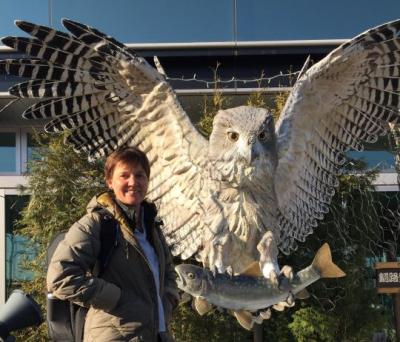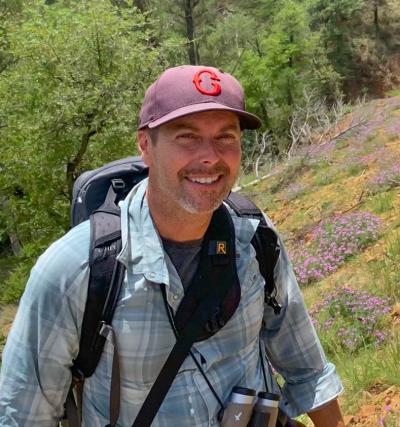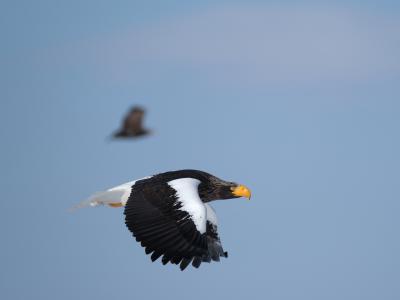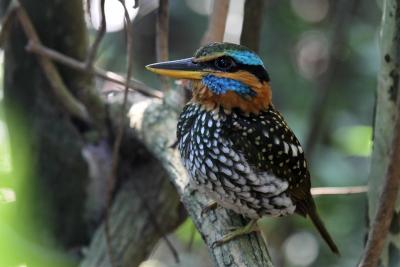Borneo: Sarawak Endemics
Black Oriole, Hose's Broadbill and Dulit Frogmouth
-
Jul 4-12, 2026
Susan Myers
2026
Single Room Supplement $260
2026
Single Room Supplement $260
Borneo is quite rightly regarded as one of the great storehouses of our planet’s incredible biological diversity. Charles Darwin’s famous description, “one great, wild, untidy, luxuriant hothouse made by nature herself,” although often said incorrectly to have been inspired by Borneo, is in fact perfect for Borneo. Sarawak, the legendary land of headhunters and hornbills, is Malaysia‘s largest state, occupying the northwestern portion of the great island of Borneo. Here, the ever-wet rainforests reach unparalleled diversity and are home to a dizzying array of tropical wildlife - a great portion of Borneo’s 650 bird species have been recorded in the state.
In the far north of Sarawak in the Ulu Trusan region, the mountainous Paya Maga IBA is one of the state’s most promising new birding destinations. It can be reached by four-wheel-drive vehicle from the town of Lawas, and the campsite in the forest at the higher elevations allow us access to some very special attractions including Bornean Frogmouth, Bornean Leafbird, Hose’s Broadbill, and the recently rediscovered Black Oriole.
Pulong Tau National Park, Sarawak’s largest reserve comprising nearly 600 sq. km of pristine montane rainforest, occupies the western flank of the Kelabit highlands of northeastern Sarawak. Its spectacular mountain landscapes include Mount Murud, Sarawak’s highest peak (2,424 m), and the Tama Abu range. The whole area is home to the ethnic Lun Bawang, meaning people of the land. Formerly known as a tribe of fierce headhunters, most have now converted to Christianity and have settled down to quiet lives of growing rice and raising chickens. Don’t worry - definitely no more headhunting! More than 300 species of birds are listed for this park, including the rare endemic Bulwer’s Pheasant and Black Partridge, although we’ll be lucky indeed to find these. With a broad altitudinal range and habitat diversity, Pulong Tau National Park is home to numerous other bird endemics including Bornean Whistler, Mountain Barbet, Whitehead’s Spiderhunter, and the enigmatic Dulit Frogmouth. One of the main villages of the Pulong Tau area is Ba’ Kelalan, situated about 1000 meters above sea level, and located deep in the Kelabit Highlands. This will be our base for three nights.
This tour is a rewarding adjunct to our main Borneo tour in Sabah and will complement that list with some strikingly different birds.
Day 1: Our tour will start with an introductory meeting at 6:00 pm followed by dinner. Night in Kota Kinabalu.
Day 2: We’ll begin early this morning in Kota Kinabalu in Sabah from where we’ll drive south towards the Malaysian state of Sarawak. We’ll stop after about an hour and half at the Klias Wetland where we’ll search for some of the most sought-after birds of the region. Our main target will be the rare Hook-billed Bulbul, restricted to lowland peat swamps which are a feature of this reserve. Other swamp forest specialists we may find include the elusive Grey-breasted Babbler, as well as Scarlet-breasted Flowerpecker, Red-crowned Barbet, and Chestnut-bellied Malkoha. Continuing to Sarawak we’ll stop for lunch at the large town of Lawas, then overland another 4-5 hours by 4WD to the Bakalalan homestay where we will stay the next three nights.
Day 3 - 4: We’ll bird two full days in the hills around Bakelalan where we’ll hope to connect with some of the celebrated montane endemics like Dulit Frogmouth, Whitehead’s Spiderhunter, Hose’s and Whitehead’s Broadbill, Mountain Serpent Eagle, Black-throated Wren-Babbler, Bornean Barbet, Mountain Barbet, Golden-naped Barbet, Crested Jay, Bornean Spiderhunter, and the handsome Blyth’s Hawk Eagle, which is often easier to find here than elsewhere on our Borneo tours. Nights at Bakalalan Homestay.
Day 5: We’ll spend the morning birding around Bakalalan and after lunch, begin the drive to Long Tuyo, with birding stops along the way. On arrival, we’ll begin our preparations for the following day’s trek to Paya Maga where we’ll spend the next two nights.
Day 6: After breakfast we’ll transfer to the Paya Maga Highlands trailhead and trek at a leisurely pace for 4 miles, birding as we go, to our simple but comfortable campsite. Using the campsite as our base we’re targeting some special endemic species; the mysterious Black Oriole, stunning Bornean Banded and Blue-banded Pittas, Hose’s Broadbill and the Bornean subspecies of Rail-babbler. Overnight Paya Maga campsite.
Day 7: After breakfast, we’ll continue our birding efforts searching for more endemic species such as Bornean Banded Kingfisher, Bornean Leafbird, Bornean Bulbul, Pygmy Ibon (White-eye) among others. Other attractive resident birds abound here and with luck, we’ll find Sunda Owlet (endemic to Borneo and Sumatra), Cinereous Bulbul, and Dayak Blue Flycatcher. One of Asia’s scarcest woodpeckers, Olive-backed Woodpecker, is relatively easy to find here. Night at Paya Maga campsite.
Day 8: We’ll have a little time this morning to bird around the Paya Maga campsite, though after breakfast we’ll need to be packed up and ready to hike back to our drop-off point. Once we’ve reconnected with our vehicles we’ll head overland to Lawas for lunch. From Lawas we’ll have a three to four hour drive back to Kota Kinabalu, where we will spend the night.
Day 9: The tour concludes this morning.
Note: The information presented below has been extracted from our formal General Information for this tour. It covers topics we feel potential registrants may wish to consider before booking space. The complete General Information for this tour will be sent to all tour registrants and of course, supplemental information, if needed, is available from the WINGS office.
ENTERING MALAYSIA: U.S. citizens are required to have a passport valid for at least six months after the date of entry and with at least one blank page for an entry stamp. Visas are not required for a pleasure or business trip of 90 days or less.
Proof of yellow fever immunization is required for people coming from countries where the disease is endemic. No other immunizations are required for entry.
COUNTRY INFORMATION: You can review the U.S. Department of State Country Specific Travel Information here: https://travel.state.gov/content/travel.html and the CIA World Factbook here: https://www.cia.gov/the-world-factbook/. Review foreign travel advice from the UK government here: https://www.gov.uk/foreign-travel-advice and travel advice and advisories from the Government of Canada here: https://travel.gc.ca/travelling/advisories.
PACE OF THE TOUR: The average distance covered during our days in the field is around 1 - 2 miles per “birding period.” Our pace is very slow, of course, and while not overly strenuous you will be on your feet for long periods. A lightweight, foldable stool may come in handy. In order to get to the remote field camp at Paya Maga (where we will spend two nights) you will be required to hike a 4-mile uphill stretch of trail. We’ll start the hike in the morning and with birding stops it will take us roughly 3 hours. The hike is mostly on a moderate grade, but participants should have a reasonable level of fitness. We’ll hope to reach camp before the heat of midday. Since there is a lull in the bird activity in the middle of the afternoon, midday breaks are usually scheduled. The mornings will be early (as early as 5:30 AM departures from the accommodations in some places). Most of our birding during this tour will be on foot and away from vehicles. Our birding at Ba’kelalan will involve some roadside birding, while at Paya Maga we’ll be on fairly wide forest trails. In order to find the more skulking birds such as pittas, partridges, babblers and so on we will also be birding on narrow forest trails and sometimes even off trail. These trails are oftentimes freshly cut and may be slippery or “rooty.” Where possible we will be walking on a downhill trend but of course, the trails undulate and since we’ll oftentimes need to return the way we came, some uphill walking is required. Susan will inform the group of trail conditions ahead of time so that anyone who wishes to opt-out has that opportunity.
The proximity to the equator means the days are 12 hours long year-round so dawn and dusk are around 6 am/pm respectively. Evening or early morning owling is offered where possible for those who want to participate.
HEALTH: The Centers for Disease Control and Prevention (CDC) recommends that all travelers be up to date on routine vaccinations. These include measles-mumps-rubella (MMR) vaccine, diphtheria-tetanus-pertussis vaccine, varicella (chickenpox) vaccine, polio vaccine, and your yearly flu shot.
They further recommend that most travelers have protection against Hepatitis A and Typhoid. Please contact your doctor well in advance of your tour’s departure as some medications must be initiated weeks before the period of possible exposure.
Malaria: The CDC recommends a malaria prophylaxis.
Yellow Fever: Yellow Fever protection is not recommended by the CDC but is required for entry into Malaysia if you’re coming from a country where the disease is endemic.
The most current information about travelers’ health recommendations can be found on the CDC’s Travel Health website here: https://wwwnc.cdc.gov/travel/destinations/list
Elevation: The maximum elevation we will bird is not high; at Paya Maga it is approximately 985ft/300m to 1970ft/600m; our accommodation there is at approximately 1640ft/500m. Bakalalan village is located at 2985ft/910m above sea level.
Smoking: Smoking is prohibited in vehicles or when the group is gathered for meals, checklists, etc. If you are sharing a room with a nonsmoker, please do not smoke in the room. If you smoke in the field, do so well away and downwind from the group. If any location where the group is gathered has a stricter policy than the WINGS policy, that stricter policy will prevail.
Miscellaneous: Malaysia is remarkably free of intestinal complaints. Malaysians are very particular about their drinking water and drinking water in a restaurant or cafe will have already been boiled.
It is likely that we will find mosquitoes in some forest areas. We recommend using insect repellents with a high concentration of DEET.
CLIMATE: Both Bakalalan and Paya Maga enjoy tropical climates that are a bit cooler than in the lowlands. The nights are fresh but usually not cold, although a jacket is advisable just in case. The temperature ranges from about 31C (mid-day) to the low-20sC at night, although the averages are cooler in the mid-20s. Paya Maga is usually marginally warmer. The humidity is quite high, averaging about 80% year-round, which may make it seem hotter. Rainfall can be expected at any time in brief, heavy downpours. Total annual rainfall averages between 200 and 260 cm (between 77-100 inches), the wet season typically runs from October to March, while the “not so wet” season is from April to September. There is always the chance of rain on any given day at any given time in Borneo.
ACCOMMODATIONS: As this tour visits a rather remote region of Borneo that lacks the tourist infrastructure and luxuries of Sabah, a sense of adventure and a decent amount of preparation will ensure you have a great trip. Our tour begins and ends in Kota Kinabalu, and while there we stay in a fairly typical, well-appointed, western-style hotel with private bathrooms. While in Bakalalan we will stay in the local “homestay” which is quite simple, with shared bathrooms, but clean and comfortable. The homestay is run by a charming local family in their very large house (they live out the back). In the living areas you will find an endless supply of snacks and hot drinks, comfortable seating, and a well-stocked library of natural history books. It is likely to be a memorable stay in a busy little village with no roads. Bathing here will either be through an overhead faucet or mandi style, which involves using a small container to scoop water out of a large container and pouring water over the body, in such a way that this water does not go back into the large container. Our two nights in Paya Maga, which is basically a remote campsite, will be much more basic. The campsite here is comprised of a small primitive wooden building with three separate rooms. One of the rooms is the kitchen and the two are for sleeping. Mattresses (3-inch foam) will be laid out on the floor and tent-like mosquito nets & light sleeping bags will be provided. You may consider bringing a sheet along with you for these nights and you may also consider bringing a travel pillow. If you are a light sleeper you may also consider bringing ear plugs. Behind the wooden building is a large outhouse with 5 simple pit style toilets (no seat) and bathing stalls (mandi). Once we leave Kota Kinabalu we may not have hot water for bathing for most of the trip.
WiFi, Internet and Cell Phones: In the hotels in the main towns free wifi is generally available. Most require a password, which we’ll receive on check-in. Neither a signal nor Wifi are available at Paya Maga. A signal is available at Bakalalan but it is weak.
Cell phones can be useful while on tour but keep in mind that many countries operate on a different cellular technology than US or Canadian carriers. Your phone may be incompatible with the local system, so please check with your local carrier.
FOOD: The food in this part of Malaysia is generally delicious and varied with a combination of Chinese, Western and local Malaysian and Sabahan dishes. At the lodges the evening meals are in the form of buffets. The food in this part of the world has a reputation for being spicy but in Malaysian cuisine, chili or “sambal” (similar in some ways to salsa) is usually added to the meal at the table and is thus optional.
Drinks: Water will be available in the field and we’ll have a large bottle for refills. We ask that bring a large, good quality water bottle and keep this topped up. Juices and carbonated beverages will not be available at some locations. At meals either bottled or filtered water will be available.
Food Allergies / Requirements: We cannot guarantee that all food allergies can be accommodated at every destination. Participants with significant food allergies or special dietary requirements should bring appropriate foods with them for those times when their needs cannot be met. Announced meal times are always approximate depending on how the day unfolds. Participants who need to eat according to a fixed schedule should bring supplemental food. Please contact the WINGS office if you have any questions.
TRANSPORTATION: During the tour we’ll travel primarily in four-wheel drive vehicles. Most of the roads used will not be paved, and depending on how recent it’s rained the roads can be quite dusty so be prepared. You should have protective coverings for cameras, lenses, and binoculars.
2023 Narrative
Day 1, May 29: We met in the evening for a short introductory meeting, including meeting Yeo from Kuching, before our delicious dinner at the Dynasty Chinese Restaurant. The pan-fried lamb chop in coffee sauce was sensational!
Day 2, May 30: A very early start at 0400 did ensure that we arrived at Klias Forest Reserve in time for some excellent birding. After a two-hour drive, we first enjoyed a car park breakfast (I think the dogs and cats ate more of it than we did, mind you) amid the morning chorus of barbets and babblers before we hit the boardwalks in search of some very special Bornean birds that are specialists of this mangrove and swamp forest. Our main target, the scarce Hook-billed Bulbul, was soon tracked down and this excellent sighting was followed by Chestnut-bellied Malkoha, Red-billed Malkoha, Crimson-winged Woodpecker and, best of all, the Red-crowned Barbet.
We then headed southwards to the other Bornean Malaysian state of Sarawak (leaving Sabah). First, we stopped for a really delicious lunch at the very Malaysian Hao Wei Restaurant in the town of Lawas. Everything was very tasty! We then transferred from our minibus to three 4WD vehicles for the long and bumpy drive into the Sarawak hinterlands. We arrived at 2000, settled into our homestay and enjoyed another delicious meal prepared by our hosts.
Day 3, May 31: This morning after breakfast we made our way up the bumpy Bario Road, near the border with Indonesia, for the first of our birding sessions in this wonderful forest. While we had many highlights this morning, one in particular caused enormous excitement – a seemingly plain bird alighted near us and was soon determined to be the near-mythical Malaysian Honeyguide. A new bird for your leader (after many years of searching for it)!
Many other great birds included the Whitehead’s Spiderhunter, Square-tailed Drongo-Cuckoo, Dark Hawk-Cuckoo, Bornean and Mountain Barbets, very cute Black-thighed Falconets, Dusky Broadbill, Pygmy White-eyes, Bornean Leafbird and even more.
In the evening, we visited an area we dubbed The Three Bridges in hopes of finding the elusive Dulit Frogmouth. This exceptionally cryptic nocturnal denizen is restricted to the mountains of this area and Ba’Kelalan is arguably the best place in the world to see it. Although we didn’t all see it tonight, we had compensation in the form of Malaysian Ear-Nightjar and an unexpected Buffy Fish-Owl perched right in the middle of the airport runway!
Day 4, June 1: Another pre breakfast attempt for the Dulit Frogmouth was successful this time, much to our delight. That thermal scope worked wonders! A noisy but elusive group of Crested Shrikejays was an added bonus. After breakfast we headed back up the Bario Road where we had a fantastic birding session.
So many highlights – how about that stunning Green Broadbill? Or the Brown Fulvetta that attacked me? Then there was the Bornean Frogmouth, White-crowned Hornbills, an Orange-backed Woodpecker, a collection of five Black-thighed Falconets, and more.
Day 5, June 2: This morning we birded around the charming town of Ba’Kelalan in order to track down some different species such as Cinnamon Bitterns, Lesser Coucal, Little Bronze-Cuckoo, Yellow-bellied Prinia and more. After some more birding in the Bario Road area, we then headed back down the road to the Long Tuyo area, our jumping off point for our trek into Paya Maga tomorrow. It was a pleasant break to enjoy our comfortable hotel room, with hot water (!), for the evening.
Day 6, June 3: We met our porters to arrange our luggage before our drivers dropped us at the trailhead for our slow walk to the Paya Maga campsite. Of course, we birded as we went and had some exciting sightings – Banded Kingfisher, Yellow-crowned Barbet, Buff-rumped Woodpecker, and Dayak Blue Flycatcher. We arrived at the campsite about midday and soon located one of our most hoped for targets, the Black Oriole, an endemic that is confined to a small montane range in Sarawak, with records from only six localities. Exciting times! Later in the afternoon, we went off trail and found some other great birds, namely Eyebrowed Wren-Babbler and Olive-backed Woodpecker to mention only two.
Day 7, June 4: Our full day birding in the Paya Maga forests was unforgettable. So many great sightings. Highlights included Rhinoceros, Wreathed and Bushy-crested Hornbills feeding in distant fruiting trees right out the front of our campsite. Later we found Black-bellied Malkoha, Crested Goshawk, Checker-throated Woodpecker, Scarlet Minivet, Maroon-breasted Philentoma, and lots of babblers and bulbuls. But most notably we had a fabulous Malaysian Rail-babbler, more Black Orioles, and a pair of Black-throated Wren-Babblers.
Day 8: June 5: We birded our way slowly back to Long Tuyo after breakfast this morning. Despite some time constraints, we managed to track down yet more excellent birds – Diard’s and Orange-breasted Trogons, Rufous-backed Dwarf-Kingfisher, Red-bearded Bee-eater, Blyth’s Paradise-flycatcher, amongst others. After a relaxing break at Long Tuyo - thanks to our friendly hosts - we headed back to Lawas for an especially delicious lunch before we took our leave of Sarawak, crossed the border back into Sabah, and made our way back to Kota Kinabalu where we finished off our tour with another yummy dinner at the Dynasty Chinese Restaurant.
Many thanks to you all for a most enjoyable and productive tour of this exciting area. Special thanks to Yeo, our hosts at Ba’Kelalan, our excellent drivers and our muscley porters. Terima kasih banyak!
Single rooms or rooms with en suite facilities won’t be available in some places. See Tour Information for details.
Maximum group size six with one WINGS leader.









